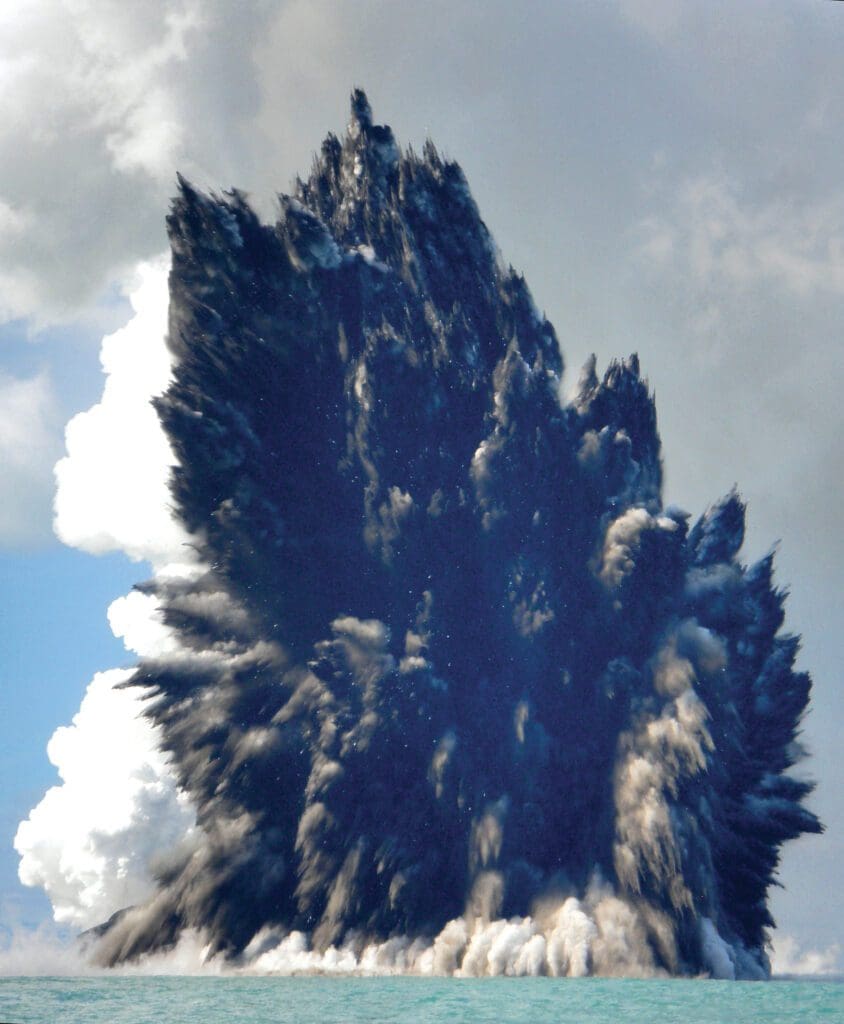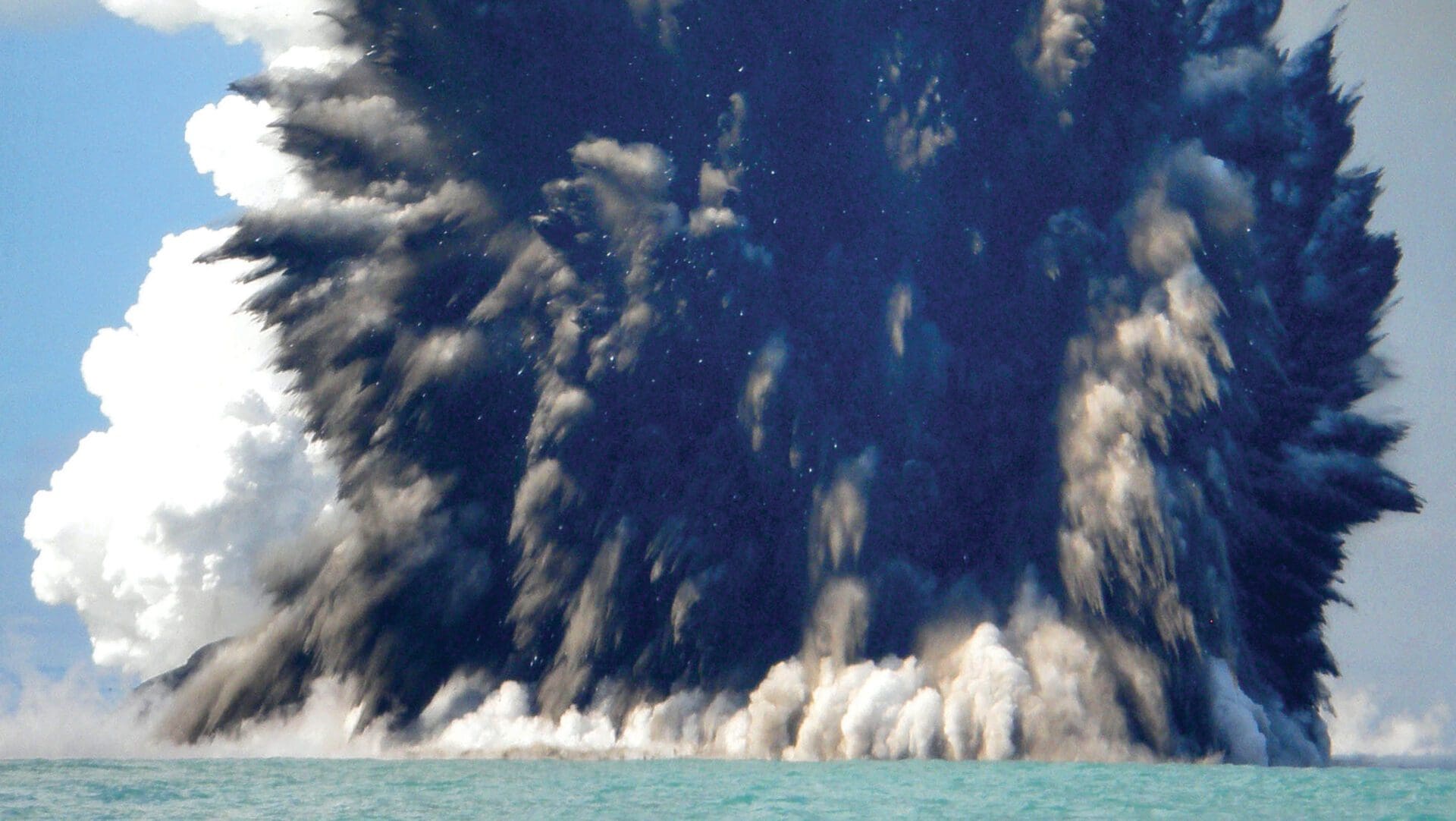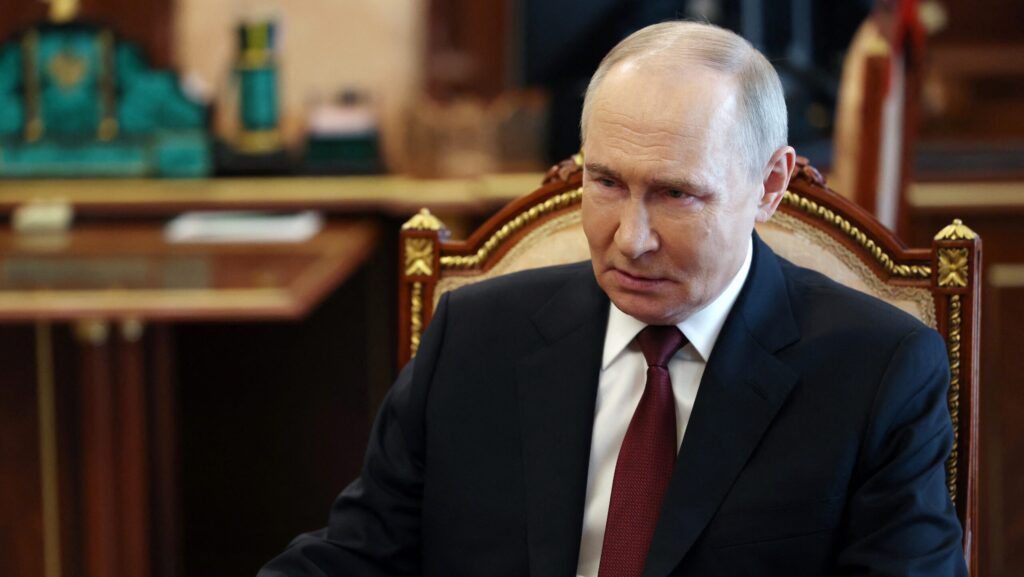Upon the advent of the new decade, it was expected that the 2020s would be challenging even without a major economic crisis or another high-impact, low-probability (HILP) event after the COVID–19 pandemic. By 2021 it became evident that globalization had stalled, and polarization among states and within societies had grown to a level unseen in decades, if not since 1945. 2022 almost began with a HILP event in January due to a 5–30 megaton volcanic eruption in Tonga, which even the most-up-to-date seismic sensors were not able to forecast. On the Volcanic Explosivity Index (VEI), the Tonga eruption was scaled level 6, making it comparable to the largest thermonuclear bomb created by mankind. The volcano produced ten cubic kilometres of volcanic matter, while its ash cloud was half the size of France.1 Likening the Tonga eruption to a HILP event is no exaggeration. Had the underwater explosion been a magnitude larger, it would have decreased the global temperature leading to dire consequences regarding global agricultural production.
The volcano eruption in Tonga thus remained a warning without serious global consequences. However, 24 February 2022 witnessed the beginning of a very substantial high-impact event, with the beginning of the second Russian aggression against Ukraine. Although the intelligence services of the United States had been warning about the Russian invasion plans for months in advance, neither the European states nor the Ukrainian leadership had anticipated it until the very last days before the attack. Russian willingness to rely on force had become apparent over the last two decades, as exemplified first by the case of Georgia in 2008, and later by the annexation of Crimea and the first invasion of Ukraine. Despite some telling signs of a possible invasion, the second Russian attack on Ukraine was unexpected by most observers. Eight months later it is clear that it has a global impact that will reverberate through the decade and will cause additional crisis spots not only in Europe, but also on faraway continents. The war started in a world already weakened by COVID–19, as well as structural economic problems in leading states such as China, the US, and several members of the EU, at a time when the first major effects of climate change are being clearly felt, and when population explosion and implosion are both major problems.
In the best-case scenario, the most violent phase of the war will conclude sometime during the winter of 2022–2023 without any international escalation. Even in this case, the death toll of the conflict may reach more than a hundred thousand, with many hundreds of thousands of wounded and millions of refugees. The direct damage of the war for Ukraine will amount to several hundred billion US dollars, and will have a lasting negative effect on the Russian and European economy as well.

Even if a relative peace is achieved by early 2023, the economic consequences of the war will be vast. The West has rightly frozen hundreds of billions of dollars in Russian assets and imposed extremely harsh sanctions on the biggest raw material supplier of the world. However, some of these sanctions—while being morally right—are hurting Europe more than Russia.
‘The total amount of natural resources found in Russia is estimated up to the worth of $75.5 trillion.’2 This fact will come back again upon us many times during the next seven lean years. The United States is a distant number two with 45 trillion. Two other countries on the top ten list, Iran (no. 5) and Venezuela (no. 10) are also heavily sanctioned. Saudi Arabia (no. 3) and Iraq (no. 9) are not truly in the Western alliance system, let alone China (no. 6), the real challenger of American power. China has built strong relations in recent years with both Saudi Arabia and Venezuela. It is worth mentioning that the former is clearly drifting away from the orbit of the United States. To put it simply, it is hard to imagine a world functioning well with a heavily sanctioned Russia, Iran, and Venezuela, an unfriendly Saudi Arabia and an unstable Iraq. Global energy prices will remain high, no doubt, for quite a long time. Supply chains will face severe difficulties leading to shortages in food and goods. The unemployment rate will increase all around the world, which, together with inflation will decrease living standards. To counter all these factors, especially considering the still lingering presence of COVID–19, will be a substantial challenge for even the most stable countries. Some will certainly fail and descend into turmoil.
Among the Western countries, the USA is expected to be affected the least by these developments and their long-term consequences. Regarding natural resources and industrial production, the United States is either self-sufficient in most fields or has the capacity to become so. Besides, being surrounded by the two oceans, the country will be only marginally affected by the highly probable new waves of African and Asian mass migration.
‘Some of these sanctions—while being morally right—are hurting Europe more than Russia’
It can be projected that in the most important regions—in Europe and in the Far East—US presence and activity will remain significant, though Washington may lose most of its influence in Africa by the end of the decade. Concerning the case of Ukraine, it should be noted that the overall goals and agenda of the United States are unclear. Washington’s approach is understandable only if the US regards Moscow as a stable ally of China or if short-term moral considerations outweigh long-term interest. While the USA, beyond defending Ukraine, seeks to diminish regime stability and exhaust the military capabilities of Russia, it also forces the Kremlin to seek the help of China. Beyond any doubt, Russia has lost considerable international prestige as a great military power, while its value as an ally has decreased as well. Bearing this in mind, from a geopolitical perspective the policy of exhaustion utilizing economic sanctions seems to be counterproductive and illogical as trade embargos—especially gas and oil trade sanctions—push resource-rich Russia towards China and financial sanctions undermine the current economic system that is advantageous to the United States. Although the redirection of the Europe-oriented Russian energy export to China may be financially burdensome and hard to implement, it could ultimately be accomplished within the decade. The weakening of the dollar and the Western hold on the global financial system may be of longer duration, however.
The war will very likely be a strategic defeat for Russia, even if it achieves a tactical victory, annexing substantial Ukrainian land—and even that is far from certain. Moscow will experience a considerable loss of influence in the world in the coming years. The first months of the Russian–Ukrainian War have revealed the weaknesses of the Russian military and it is clear now that there is a wide development and innovation gap between Russia and the West in all fields of military technology, to the advantage of the latter. In the last two decades, Vladimir Putin made the right decisions to maximize Russian influence and power. Before 2022, Russia had never crossed the red lines drawn by the United States, and used to be successful not only in Syria, Belarus, and Central Asia, but even in Ukraine. Ukraine was not a good-news story before the invasion, nor a democratic example to be afraid of, and was not on the verge of success. This makes the Russian invasion even more incomprehensible.
Moscow may have thought that Ukraine would collapse quickly, while its own economy would easily survive the sanctions. The Russian economy proved to be resilient to the sanctions imposed in 2014, and although the standard of living decreased slightly, Moscow even managed to build up new industries and increased agricultural production. This time, it will be different and with a long-lasting negative impact on Russia—and Europe.
Russia could have taken advantage of the energy price boom in the post-COVID–19 era to finally modernize its economy. The assets prepared for the war, along with the extra profits of the energy market, could have been spent on technological innovation, which additionally could have boosted the development of the economic sectors outside the energy industry. However, due to the events of February 2022, these opportunities have been lost, very probably permanently.
The real aspirations, strategy, and vision of Vladimir Putin are unknown. Nevertheless, it is certain that a portion of the Russian elite disagrees with the present course of action, and moreover, should the war continue beyond the summer of 2023 and the mobilized population endure heavy losses, Putin’s strong political support from Russian society may gradually erode. There is a possibility that Russia may have a new leadership in the near future, which raises a number of questions with regard to Moscow’s foreign policy orientation in the upcoming decade. The most crucial questions are whether Russia would be stuck in an alliance with China or could reach a compromise solution with the West to lift the sanctions. Unfortunately, it is more likely that after the end of the Putin era the current course will continue. It was not only the personal drive of Vladimir Putin, but wounded Russian national pride, nationalist beliefs and perceived interest that led the country into a confrontation with the West, although many experts failed to identify these underlying factors. As Russian writer and Nobel laureate Alexander Solzhenitsyn put it in a 2007 interview, the spread of NATO’s influence ‘was especially painful in the case of Ukraine, a country whose closeness to Russia is defined by literally millions of family ties among our peoples, relatives living on different sides of the national border. At one fell stroke, these families could be torn apart by a new dividing line, the border of a military bloc.’3 Therefore, regardless of Putin’s successor, it is unlikely that the new Russian president could govern without taking into consideration the national sentiments and perceptions of the leaders in the military and the powerful intelligence services, and altogether of the majority of the Russian nation. There is a probability that a new regime could be even more nationalist than Putin’s.
For the People’s Republic of China, the Russian–Ukrainian War simultaneously provides opportunities and poses threats. The war itself may burden the Chinese economy, already seriously affected by the pandemic and other woes, while the decrease of Russian prestige also devalues Moscow as an ally. The worse than expected Russian military performance in Ukraine opens up questions concerning the effectiveness of the Chinese military, since the majority of Chinese weapons are based on Soviet/Russian technology, while the new weapons developed by China have not been tested yet in a war. Additionally, the organization and training of the Chinese Army in most cases follows Soviet practices, which cannot be regarded as highly efficient. Consequently, the Russian military weaknesses may indirectly affect China’s military prestige as well, prompting the rivals of Beijing to act more confidently. Nonetheless, the war also provides opportunities for Beijing. Chinese leverage against Russia in all fields of diplomacy and trade—including energy, resources, and military technology—is being strengthened. It is important to note that Chinese public opinion sided decisively with Russia in the conflict, which can be regarded more as the product of Chinese nationalism and anti-US sentiments than of state propaganda.
The most unpredictable scenario for Beijing would arise from a conflict with Taiwan. Chinese nationalism is strong, and the leadership of the country must accommodate it. Systemic economic problems may also drive the Chinese leadership to a more confrontational stance, especially if the US continues to openly challenge Beijing in Taiwan. The question of how flexible Xi Jinping can be on the issue and what his personal aspirations are, is a major unknown. It is also an open question when the Chinese Army would be able to execute an invasion successfully. But if China avoids a war in Taiwan, despite its economic problems it can weather the coming lean years better than most countries.
It is hard to predict how much Chinese global influence will increase in the coming years, but it is almost certain that China’s positions will be stronger than it is now. Although the Chinese would become the largest economy in the world, the country will still lag behind the West in GDP per capita. But overall size does matter, and Chinese technology is catching up with the United States and Europe with surprising speed. Possible Russian technology transfers can help sectors lagging behind, such as the construction of submarines or aircraft engines, and space technology.
The Russian invasion of Ukraine poses a major challenge for the European Union. In case of an escalation, the challenge may become existential. The war has already raised energy prices, while further sanctions introduced without careful consideration may result in long-term and irreversible damage for the European economy, especially for Germany. The often ideologically motivated decision-making in the EU is undoubtedly problematic. In a polarized world, it would be important to end ideological battles and conflicts within the EU, but this is unlikely to happen in the medium term. Only a sweeping political change could end the age of such destructive political decisions as the closing of German nuclear power plants, the open-door migration policy, and the lack of serious investment in European militaries.

The developments of 2022 have changed somewhat the overall approach to the armed forces, but Europe will not attain strategic autonomy in the medium term, even with considerable spending increases by the largest member states, Germany, France, Italy, and Spain. The Russian–Ukrainian War will strengthen NATO, rather than the EU’s common defence. The Eastern member states have far more trust in the USA than in Germany or France. In the upcoming years, beyond Russia, the major threats posed to Europe will be the destabilization of the Middle East and Africa, which could provoke a far larger migration crisis than that of 2015. Without managing the challenge of high energy prices, migration, and ideological decision making, the EU will face a bleak future.
The double challenge of the effects of Russian invasion and the COVID–19 pandemic will worsen the situation of the Middle East and Africa. Food prices have hit a record high due to the decrease of Russian and Ukrainian exports, and the insufficient quantity of available fertilizer. That could lead first to a food crisis, then to political upheaval in these vulnerable regions. Climate change also has detrimental effects, worsening the food situation in most countries, especially in the Sahel.
Overpopulation also plays a significant role in the destabilization of the continent. The population of Africa is growing rapidly, and even the most developed countries would not be able to adequately manage an annual 2–3 per cent increase in population. While in 1996 Africa’s population had just surpassed Europe’s, by 2030, the population of the continent is going to increase by a further 300 million compared to 2022, making it an overall astonishing 1.68 billion, more than twice the population of Europe and Russia combined.4 Each year the number of young adults seeking job opportunities, but without any realistic prospect, will increase considerably. There is no solution in sight for Africa to tackle mass unemployment. The most important question is whether the most populous and already fragile states of Africa—like Nigeria, the Democratic Republic of the Congo, Ethiopia, and Egypt—will be able to avoid further destabilization and civil wars. Nigeria’s population will reach half of the EU’s by 2030. 268 million people living in a country less than 1.5 times the size of France, with deep ethnic and religious dividing lines, and negatively affected by climate change is almost certainly a recipe for serious conflict and previously unforeseen waves of migration.
In contrast to Africa, India is likely to be able to manage language and religious diversity and population pressure during the coming lean years. Over the last four decades, the growth of the population has halved, and now the birth-rate is just above replacement level, with 2.2 children per woman.5 At the same time, India has become the fastest-growing large economy in the world, and not only can it provide its citizens with sufficient quantities of consumer goods but it is able to raise their standard of living as well. In the region, a food crisis would affect India the least, while the country may gain a significant advantage in the upcoming years should it secure Russian oil at lower than the global price. Due to the country’s global significance, New Delhi may be able to balance its foreign policy between Russia and the West, benefiting from good relationships with both sides. If not in 2023, then in a few years, India’s population will surpass China’s, becoming the world’s most- populous nation.6 Soon it will also become the world’s third largest economy, outperforming the United Kingdom by 2025, Germany by 2027, and Japan by 2030.7
‘The real aspirations, strategy, and vision of Vladimir Putin are unknown’
For Hungary, these global developments are generally negative, as the country is on one of the main migration routes to Europe. The regional outlook is not favourable for the country either. There are acute dangers arising from the Russian invasion of Ukraine. Further escalation cannot be ruled out, with unpredictable consequences. The Hungarian community in Ukraine, Magyar sites of major religious, historical, and cultural importance, as well as Hungarian economic interests are already very negatively affected. There are no ‘good’ solutions for the war: even a complete Ukrainian victory would leave the region with serious challenges, the most important being that an unstable Russia may be unwilling or unable to deliver energy to resource-poor Central Europe. The international tensions generated by the aggression against Ukraine will remain with us for a long time. Even if the intensive phase of the Russian–Ukrainian War concludes, the continuing conflict in Ukraine will differ from the frozen conflict of the Donbass region after 2014. There is very little chance that the relative peace of 2021 will return for years to come.
The future of the Republic of Moldova is also in question, mainly due to Russian aggression, but because of other factors as well. Any infringement of the sovereignty and independence of Moldova would directly and negatively affect Hungarian interests, and such eventualities cannot be ruled out. Moldova can clearly be affected by the military conflict, but the indirect effects, especially the lack of natural gas and electricity, may also prove to be very severe.
Besides the war in Ukraine, there are several other possible crisis spots in the region. The stability of the Balkans was already shaky before the war. Bosnia–Herzegovina and Kosovo have deep internal problems. While the return of full-scale violence is unlikely in the short term, a global economic crisis could sharpen existing tensions between Serbs and Kosovars, and among Serbs, Croats, and Bosniaks.
Hungary’s security is today mainly based on its NATO membership, but we tend to forget that NATO’s strength is rooted in the commitment of the United States to Europe. Consequently, the biggest threat to Hungary’s security would be any decrease of cohesion among NATO members, particularly should the focus of the USA be significantly redirected to another continent or should Washington return to an isolationist policy. In light of the Russian–Ukrainian War, such a scenario seems less probable; nonetheless, if the crisis becomes global, especially if it involves China, attitudes and interest might change in Washington. Europe is less important for many in the US than China, for obvious and understandable reasons.
Even with a strong NATO and EU, Hungary will face several years of global and regional turmoil and uncertainty. This is not a possibility, it is a certainty. Besides seeking regional partners, the speeding up of the Zrínyi 2026 National Defence and Armed Forces Development Programme is also of major importance. Considering the experience drawn from the Russian–Ukrainian War, the strengthening of territorial defence forces and the modernization of their equipment is also of paramount importance. Decreasing hydrocarbon energy dependency in the shortest possible time is a Hungarian national interest, which could be achieved through expanding nuclear, solar, and geothermic power generation. Fortunately, the development of these areas has already started, but the acceleration of these projects would be of vital interest as the security environment of Hungary is less stable than at any time since 1945. The lean years are here, and we will be fortunate if there are only seven of them.
NOTES
1 David Nield, ‘It’s Official: Tonga’s Volcano Was the Largest Explosive Eruption of the 21st Century’, Science Alert, https://www.sciencealert.com/tonga-s-volcanic-eruption-was-the-largest-explosion-of-the-21st-century, accessed 22 October 2022.
2 ‘TOP 10 Countries with Most Natural Resources in the World’, https://www.basicplanet.com/top-10-countries-natural-resources-world, accessed 22 October 2022.
3 Der Spiegel interview with Alexander Solzhenitsyn, ‘I Am Not Afraid of Death’, https://www.spiegel.de/international/world/spiegel-interview-with-alexander-solzhenitsyn-i-am-not-afraid-of-death-a-496211.html, accessed 26 October 2022.
4 United Nations, ‘Population 2030: Demographic Challenges and Opportunities for Sustainable Development Planning’, (New York: UN, 2015), https://www.un.org/en/development/desa/population/publications/pdf/trends/Population2030.pdf, accessed 20 October 2022.
5 ‘Fertility Rate, Total (Births per Woman)’, World Bank, https://data.worldbank.org/indicator/SP.DYN.TFRT.IN, accessed 20 October 2022.
6 ‘India’, Population Pyramid, https://www. populationpyramid.net/india/2030, accessed 10 October 2022.
7 ‘India to Become 5th Largest Economy in 2025, 3rd Largest by 2030’, The Economic Times, https://economictimes.indiatimes.com/news/economy/ indicators/india-to-become-5th-largest-economy-in-2025-3rd-largest-by-2030/articleshow/79964750. cms?from=mdr, accessed 20 October 2022.








